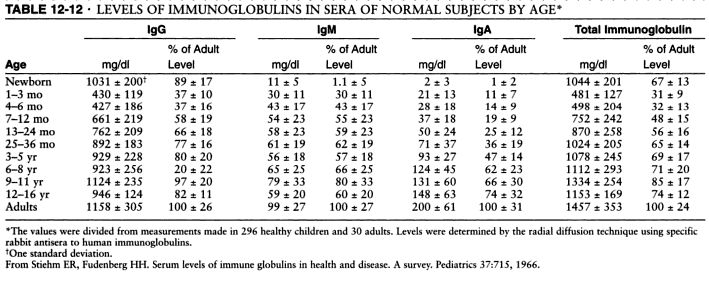Reviewer: S. Randhawa, M.D., Allergist/Immunologist and Assistant Professor at NSU
A 16-year-old boy is here for evaluation of suspected IgA deficiency. He had extensive blood work testing for suspected celiac disease 6 months ago. His IgA level was 17 mg/dL. IgM, IgG were normal. He does not have a history of recurrent infections. The scan for celiac disease was negative. A month ago, his IgA level was found to be 7 mg/dL and he is here for evaluation. He has no history of frequent ear, sinus, or lung infections or any other recurrent infections. He has no diagnosis of asthma, allergic rhinitis, food allergy, or atopic dermatitis.
Past medical history and surgical history is negative. Current medications: none.
Physical examination is unremarkable for acute allergic disease.
What is the most likely diagnosis?
This is a patient with suspected IgA immunodeficiency which occurs in approximately 1 in 500 individuals. The majority of these patients are asymptomatic. The definitive diagnosis of IgA immunodeficiency is made by an IgA level of less than 7 (he had one borderline value), and also by the evidence of normal IgM and IgG values. If the patient is asymptomatic, no further treatment is indicated.
What is the next step in the management?
Regarding his possible diagnosis of IgA immunodeficiency, I suggested repeated IgA, IgM, and IgG levels during the next 3 to 12 months.
If his IgA level is less than 7 mg/dL, he has a definitive diagnosis of selective IgA immunodeficiency.
If the IgA level is higher than 7 mg/dL (but lower than 2 standard deviations below the mean for his age), he has a possible IgA immunodeficiency.
The management consists of avoidance of infections as much as possible, and early treatment of any febrile illnesses and infections with antibiotic. IVIG or subcutaneous IgG replacement is not indicated in patients with IgA immunodeficiency.
I suggested recheck of his IgA, IgM, and IgG levels in 1 year from now. If celiac disease evaluation is still indicated, then endoscopy and biopsy may be a better option rather than tissue transglutaminase IgA, considering that his total IgA level is low.
Summary
Humoral immunodeficiency is commonly defined as IgG, IgM or IgA level that is two standard deviations (2 SD) below the mean level for IgG, IgM or IgA, respectively, for the particular age group and gender.

Serum levels of IgM, IgG and IgA. Source: Pediatrics, 1966 and Immunologic disorders in infants and children, by E. Richard Stiehm, Hans D. Ochs, Jerry A. Winkelstein.
Typical pattern of immunoglobulin levels (IgG, IgA, IgM) in humoral immunodeficiency. Click here to enlarge the table.
References
Serum immunoglobulin levels in healthy children and adults. J. W. Stoop, B. J. M. Zegers, P. C. Sander, and R. E. Ballieux. Clin Exp Immunol. 1969 January; 4(1): 101–112.
The relationship of race, sex, and age to concentrations of serum immunoglobulins expressed in international units in healthy adults in the USA. S. E. Maddison, C. C. Stewart, C. E. Farshy, and C. B. Reimer. Bull World Health Organ. 1975; 52(2): 179–185.
Serum immunoglobulin concentrations in preschool children measured by laser nephelometry: reference ranges for IgG, IgA, IgM. D Isaacs, D G Altman, C E Tidmarsh, H B Valman, and A D Webster. J Clin Pathol. 1983 October; 36(10): 1193–1196.
Immunoglobulin levels and function in pre-school children with recurrent respiratory infections.
D Isaacs, A D Webster, and H B Valman. Clin Exp Immunol. 1984 November; 58(2): 335–340.
Serum Immunoglobulin Levels Throughout the Life-Span of Healthy Man. Ann of Int Med, November 1, 1971, Vol. 75 no. 5 673-682.
Diagnostic Criteria for Primary Immunodeficiencies. Mary Ellen Conley, Luigi D. Notarangelo, and Amos Etzioni Representing PAGID (Pan-American Group for Immunodeficiency) and ESID (European Society for Immunodeficiencies). Clinical Immunology, Vol. 93, No. 3, December, pp. 190–197, 1999.
Recognizing Primary Immune Deficiency in Clinical Practice. Clinical and Vaccine Immunology, March 2006, p. 329-332, Vol. 13, No. 3.

Five immunoglobulin classes (mind map)
In order of their serum concentrations:
IgG 1000 mg/dL
IgA 200 mg/dL
IgM 150 mg/dL
IgD 4 mg/dL
IgE 0.005 mg/dL (extremely low serum concentration compared to other Ig in (GAMED)
IgG and A are divided in subclasses: 4 for IgG -- IgG1, IgG2, IgG3, IgG4, and 2 for IgA -- IgA1 and IgA2.

Ig structures. Image source: Wikipedia.
Published: 07/12/2010
Updated: 05/06/2012
No comments:
Post a Comment